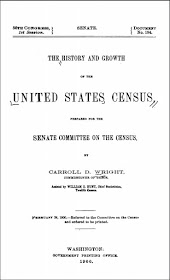 |
| https://www.census.gov/history/pdf/wright-hunt.pdf |
From a genealogical viewpoint, the actual number of people in the part of North America who would have been counted in a European immigrant oriented census if one had been held before 1790 was fairly limited. The estimated European immigrant population of North American (excluding Spanish speaking people) started out in 1610 at about 350 and increased to about 3.9 million in 1790. Between 1790 and 1850 when the U.S. Federal Census first listed the entire family membership, the population is estimated to have increased to 23.1 million. We always need to remember that population estimates are cumulative and a baby born in 1610 could have still been living in 1690. Likewise, the current population estimate of the United States of about 327.2 million people includes people who could have been born in about 1920.
Now getting into the numbers, here is a chart from the U.S. Census Bureau with the number of people counted in each of the U.S. Federal Censuses. You can click on the image to see more detail or on the link to see the original.
 |
| https://www.census.gov/population/www/censusdata/files/table-2.pdf |
Hacker, J. David. "New Estimates of Census Coverage in the United States, 1850—1930." Social Science History 37, no. 1 (2013): 71-101. Accessed February 20, 2020. www.jstor.org/stable/23361113.
Access to the article is limited to subscribers or subject to a paywall, but the abstract indicates that there has always been an undercount and that the 1870 U.S. Federal Census has the highest rate of omissions. Because of the relationship between the U.S. Census numbers governmental representation, the issue of an undercount is highly politicized. Estimates of undercounts from 1880 to 1980 range from a low of 1.4% in the 1980 U.S. Federal Census to a high of 7.4 % in the 1890 census which was lost due to a fire and government bungling. The older estimates of the undercount in the 1850, 1860, and 1870 censuses range from 9% to as high as 23%. See the following article.
King, Miriam L., and Diana L. Magnuson. "Perspectives on Historical U.S. Census Undercounts." Social Science History 19, no. 4 (1995): 455-66. Accessed February 20, 2020. doi:10.2307/1171475.
The fact that there is an undercount should alert genealogists to the possibility that an over-reliance on census records to exclusion of other records would be extremely unwise. If you apply the figures for the undercount to the estimates for the population, you can begin to see that a missing name would not be an unusual situation to encounter.
One solution is to search for people in multiple census records particularly if there are state or local censuses. Even if a person was overlooked in one census, it is always possible that the person was counted in a succeeding census enumeration. These issues with the U.S. Census do not affect the utility of the census records, but they do imply that the undercount renders the census records unreliable, the numbers merely show the need to do thorough and as nearly possible using all the available records.

No comments:
Post a Comment